Start Licensing’s Ian Downes takes a look at some examples of licensing partnerships built around ‘real’ people.
My retail travels this week have been punctuated with personalities and people.
There seems to be a lot of licensing and licensing like activity at the moment built around partnerships with ‘real’ people, Whether this is a trend it is difficult to call, but there does seem to be something in ranges and partnerships that are built in this way. Arguably this is connected to a drive for more authenticity and purpose in the commercial world.
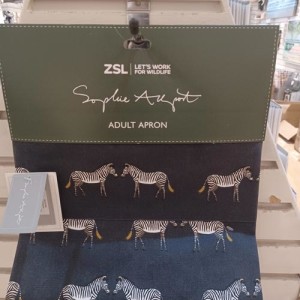 There have, of course, always been artist-based collaborations. Generally these see well known artists and illustrators creating bespoke artwork for partner brands.
There have, of course, always been artist-based collaborations. Generally these see well known artists and illustrators creating bespoke artwork for partner brands.
A live example of this that I spotted in an independent gift shop is a collaboration between artist Sophie Allport and ZSL (London Zoo). Products include aprons featuring repeat patterns of Sophie’s interpretation of animals like zebras and elephants. Partnerships like this allow brand owners to explore new design styles with credible and experienced artists. Also generally these artists bring a retail and consumer following with them. For the artist it builds new connections and provides a fresh creative direction.
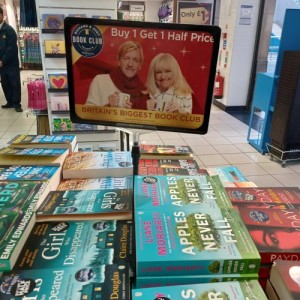 A long-standing personality driven partnership in retail is WH Smith’s link with TV personalities Richard Madeley and Judy Finnegan – aka Richard and Judy. They have developed the Richard & Judy Book Club which is billed as ‘Britain’s Biggest Book Club’ – this is a ‘club’ that grew out of their TV programme and is based around their book recommendations. Selections are centred on fiction books.
A long-standing personality driven partnership in retail is WH Smith’s link with TV personalities Richard Madeley and Judy Finnegan – aka Richard and Judy. They have developed the Richard & Judy Book Club which is billed as ‘Britain’s Biggest Book Club’ – this is a ‘club’ that grew out of their TV programme and is based around their book recommendations. Selections are centred on fiction books.
It seems to be going from strength to strength. It is an initiative which is popular with publishers as it creates momentum and focus that drives sales. A nod from Richard and Judy has a strong impact on sales and for readers their recommendations are trusted. It gives readers buying confidence as they trust the recommendations made.
WH Smith is deploying a similar tactic in the business book section where it has linked up with Dragon’s Den star and business guru Steven Bartlett. He makes recommendations from WH Smith’s business book list. Again here the selections help readers navigate a category and for the retailer it builds a strong point of difference.
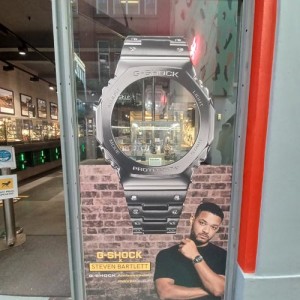 I noticed that Steven Bartlett has a partnership with G-Shock watches. He was featured on a poster in the G-Shock shop in Carnaby Street wearing and promoting his watch. He was obviously well known before Dragon’s Den and, of course, successful in business but his profile has increased since being on the show.
I noticed that Steven Bartlett has a partnership with G-Shock watches. He was featured on a poster in the G-Shock shop in Carnaby Street wearing and promoting his watch. He was obviously well known before Dragon’s Den and, of course, successful in business but his profile has increased since being on the show.
He is a very credible personality who knows his subject, but is also a great role model in the business world. In the context of G-Shock it is easy to see why it has partnered with Steven Bartlett.
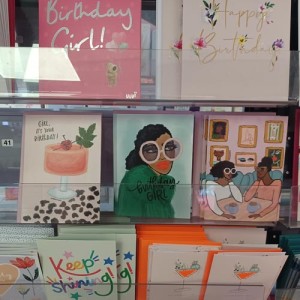 While in WH Smith it was great to see that it has a number of Kendra Dandy’s Bouffants and Broken Hearts greetings cards in-store – and well displayed at the front of the store, too. Kendra’s artwork is heavily influenced by her life and lifestyle.
While in WH Smith it was great to see that it has a number of Kendra Dandy’s Bouffants and Broken Hearts greetings cards in-store – and well displayed at the front of the store, too. Kendra’s artwork is heavily influenced by her life and lifestyle.
The range is part of a wider move by WH Smith to offer a more inclusive product selection in the greeting cards category.
I have worked on this range with UK Greetings and it really represents Kendra’s work well. I think it is a great example of a ‘hands on’ collaboration that is tuned into wider society.
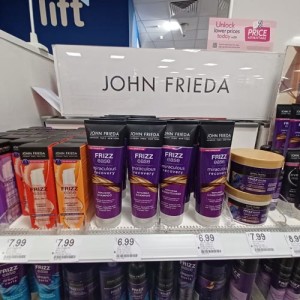 Health and beauty have always been categories that lean heavily on ‘real’ people and it is interesting to see how brands evolve in this category. Seemingly, partnerships can start with a small range of products but then grow into very significant brands – but they seem to succeed as the original ethos behind them is one built on industry knowledge, authenticity and bringing a new edge to a category.
Health and beauty have always been categories that lean heavily on ‘real’ people and it is interesting to see how brands evolve in this category. Seemingly, partnerships can start with a small range of products but then grow into very significant brands – but they seem to succeed as the original ethos behind them is one built on industry knowledge, authenticity and bringing a new edge to a category.
Some good examples of this in Boots at the moment can be found in the haircare category with ranges from Charles Worthington, John Frieda and Lee Stafford all to the fore with dedicated product bays. From the outside it is never easy to gauge the commercial basis of deals like these, but I would imagine they all have had or have a licensing element to them at some stage. In some cases, like John Frieda, the brand and brand identity have been bought by a third party. These are good examples of brands built on authenticity that have staying power in a competitive category.
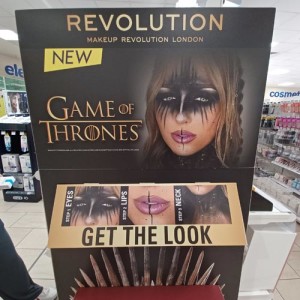 It was also interesting to see a strong presence for Kylie Jenner in-store with a full bay of make up and cosmetics. Another interesting range in-store – not a personality based one though – was a Game of Thrones range developed by Revolution London.
It was also interesting to see a strong presence for Kylie Jenner in-store with a full bay of make up and cosmetics. Another interesting range in-store – not a personality based one though – was a Game of Thrones range developed by Revolution London.
The range was sited in two locations in store including a FSDU. This carried a strong visual from the series and the message ‘Get The Look’. Products included lip sticks, eye shadows and accessories. It certainly stood out in-store, not least because it was quite different to other product offerings. It was a really well merchandised with a clear identity and is using the licence in a clever way, but also a way to seems relevant to the category. Elsewhere in-store there were Revolution x Game of Thrones gift sets – again nicely presented and obviously well timed for Christmas.
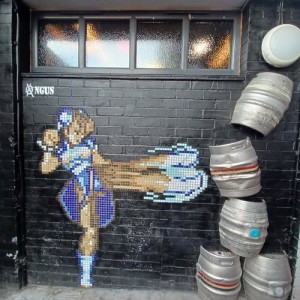 Outside of the world of personality-led products I am always interested to see how well known IP pops up in pop culture settings, particularly street art. I was in Bristol this weekend and spotted some great examples of ‘famous characters’ featuring in some very creative street art works. These included a pixelated Smurf mosaic; a very clever use of a gaming character in a pub courtyard – the artwork integrated beer barrels into it (I think the character is from Streetfighter) and various Robin, Robin characters that were part of a street art trail around the city. There is a lot of talent in the street art world and it is interesting to see how street art is now crossing over into the mainstream – for example there is a street art work by Dreph featured regularly on Eastenders.
Outside of the world of personality-led products I am always interested to see how well known IP pops up in pop culture settings, particularly street art. I was in Bristol this weekend and spotted some great examples of ‘famous characters’ featuring in some very creative street art works. These included a pixelated Smurf mosaic; a very clever use of a gaming character in a pub courtyard – the artwork integrated beer barrels into it (I think the character is from Streetfighter) and various Robin, Robin characters that were part of a street art trail around the city. There is a lot of talent in the street art world and it is interesting to see how street art is now crossing over into the mainstream – for example there is a street art work by Dreph featured regularly on Eastenders.
Of course, Keith Haring’s artwork is well established in licensing already, but a key to street art success seems to be artists establishing a style and being authentic. In a sense having a personality.
Ian Downes runs Start Licensing, an independent brand licensing agency. His Twitter handle is @startlicensing – he would welcome your suggestions for what to look out for.































